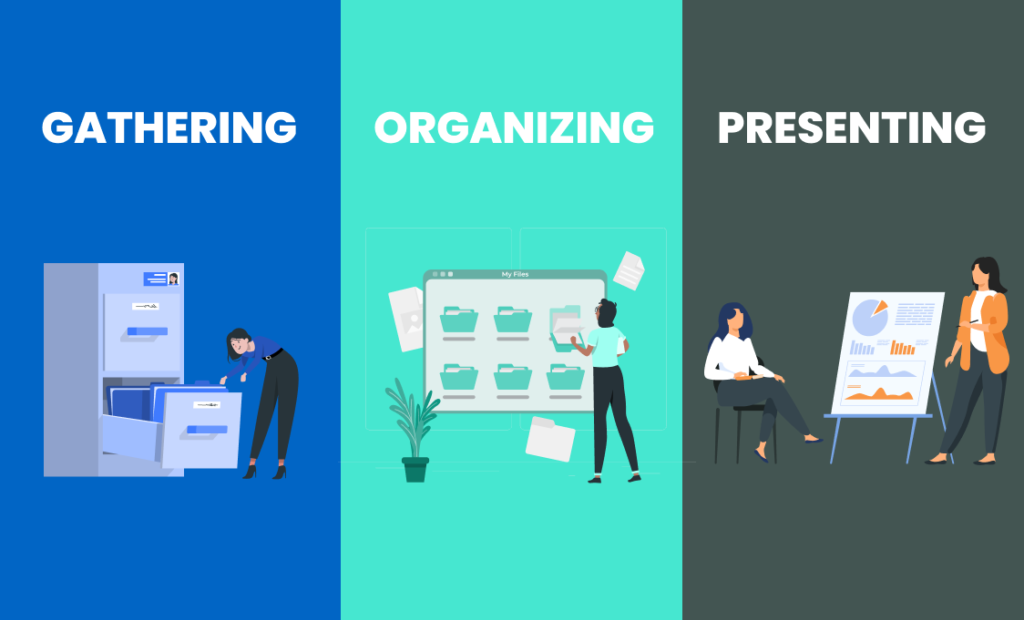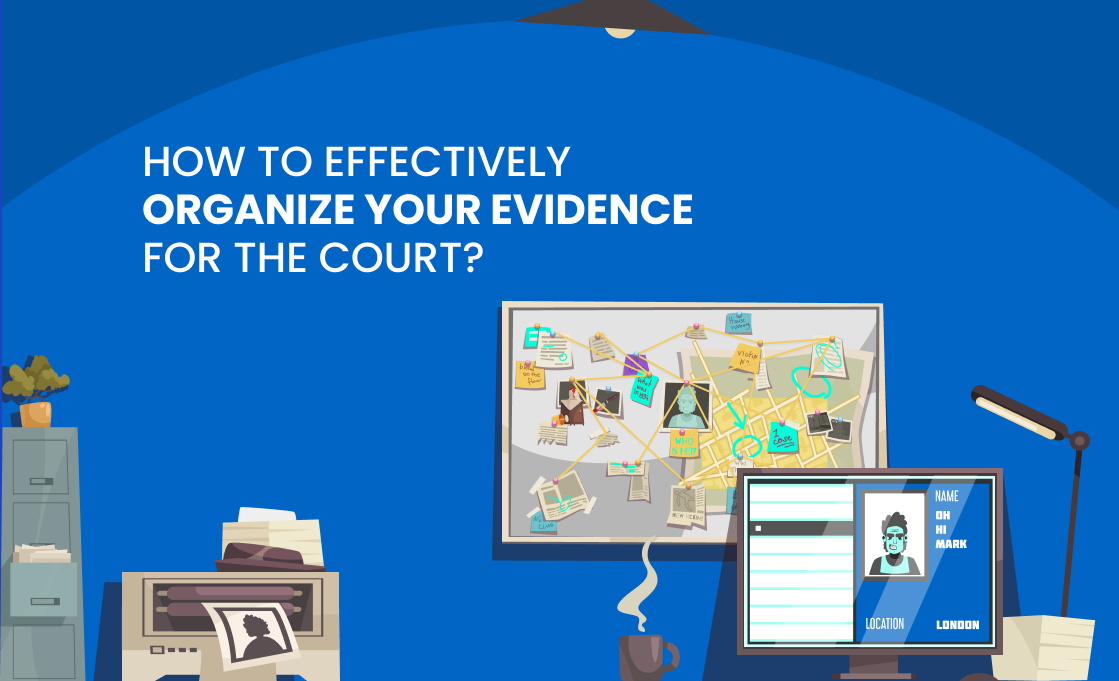In the US, UK, Canada, and across the whole world, we all get to hear the stories of mishandled work when it comes to the management of shreds of evidence and reports and getting the most accurate data, and synchronizing it to the right place. We know quite well that preparation is pivotal for a trial to be a success. You wouldn’t want to go on a hike to Mount Everest in a pair of flip-flops.
You have worked hard for months to gather evidence, documents, & arranging paperwork in preparation for one thing – the trial. One of the important aspects of the trial to go smoothly from your side is the preparation of raw evidence and trial exhibits. When lawyers are well organized and efficient, they appear to be more credible and productive in courtroom proceedings. Being well organized not only helps to convey your points in a positive way it also keeps your serenity intact.
For complicated litigation cases, there could be tens of exhibits consisting of hundreds of pages of documents that must be organized in an effective and in a particular way to ensure that evidence is easy to find when a lawyer needs it. Nothing will rattle the flow of litigation like a lawyer who stumbles to locate the evidence he wishes to present in the courtroom. Juggling with too much evidence will make him lose the attention of the jury and it may be difficult to regain the same momentum he had prior.
There was a time when lawyers used to practice law in the old traditional way, in other words, “the offline way”; everything from paperwork to evidence to every detail was recorded in ledgers, notebooks. The same goes for trial exhibits, a single case would have piles of paperwork just relating to evidence. Getting documentary evidence was a ponderous and time-consuming task: you would ask the client for copies of bills, filing of multiple forms, etc. and when the client had them, they would either bring the documents to your office or mail them to you. Now, clients usually respond to a request for documentation with a scanned version of the document within minutes.
The legal sector is slowly climbing towards technology, with this pandemic legal sector’s growth in legal tech has significantly increased with lawyers using technology for organizing themselves better. With piles of paperwork and exhibits available offline and uploading it online needs the right tools like evidence management software. An evidence management software is not a document management software but an all-in-one from storing your pivotal documents to recordings, videos to anything that can be considered as evidence. Evidence is what is used at trial to prove the elements of your case in the courtroom. Evidence includes all types of documents, emails, recordings, physical objects, messages. Not all evidence presented will be marked as an exhibit. However, as a lawyer, it’s your job to have all the crucial documentation organized and handy. Before you prepare your evidence for the courtroom, you need to analyze and organize the evidence you’ll need.
Here are some of the best practices to effectively organize your evidence

After you have gathered all the materials you need for evidence you must have got a rough idea of the kinds of evidence you possess. Storing all the evidence under the category in evidence management software will help you to be more organized and productive. There are majorly four categories to choose from.
- Scientific, Demonstrative, And Experimental Evidence
Scientific evidence is evidence that is produced by scientific procedures like tests. Demonstrative evidence includes physical objects, apparel, weapons, pictures, etc.
Experimental evidence is an experiment conducted outside of the court for the issue related to the case. Keeping them in a category will give you a streamlined flow of information.
- Documentary Evidence
The most commonly used evidence at trial is documentary evidence including all kinds of writings, printed, photocopied, documents, or any tangible evidence. Storing all documents in a single place will give more accessibility on the go.
- Witnesses
Witnesses are called on to testify as to all kinds of tangible evidence, as well as events and facts about which they have personal knowledge. Recording contact details about witnesses in the evidence management software will create an effective flow of information.
- Discovery Evidence
Evidence that is obtained in the discovery process of a case through depositions, interrogations, etc. In evidence management software, you can save all your information of the discovery phase from videotapes to forms.
Having all the evidence in front of you it’s not enough, you must prepare it for trial. The following factors and issues need to be addressed while getting ready evidence. Keeping everything in a single place will give you an advantage as all the case studies will be in front of you.
- Relevance– The proof should be relevant to show any of the information or occasions of your case.
- Witnesses– Witnesses can be required to introduce portions of proof through testimony and will also testify as to records approximately which they’ve personal know-how. You should pick the quality witnesses for each piece of evidence to present in the courtroom.
- Authenticate The Proof– Physical evidence needs to be authenticated, meaning it must be identified and have to be proven to be what you say. You need to decide which witnesses will testify as to which item(s) of evidence. In case you are handling written evidence, recording, or photograph, you should have the copy to the same if it is authorized in the courtroom.
- Lay a Foundation– For some sort of evidence to be admissible, you should satisfy certain preliminary requirements, or lay a basis for admissibility. A lay witness needs to have personal knowledge about records to which he or she is testifying. A professional witness must be qualified to testify about the unique evidence. documents ought to be real.
- Logistical Problems– Will there be any logistical issues to introducing the evidence? Will you require a computer inside the court to reveal something to the jury? Will your courtroom be technically superior sufficient to deal with the evidence you wish to provide? Do you have a large show-off that can be difficult to deliver into court? Will a chunk of proof ruin before you get to court? All these questions should be answered prior and solutions should be allocated.
The high-quality manner to begin organizing, is to from the beginning, in the following ways
- Pretrial Declaration
You understand that the courtroom is going to have you attend a pretrial eventually and that you’ll have to do a pre-trial declaration, so why not begin one at the very start of the case? beginning it then will give you a working file and list to this point as proof to be offered from witnesses, recordings, voice-mails, and documentary evidence that are ought to be involved. No more going through piles of paperwork after record to find what would possibly need to be included in the statement and no more for preparing for trial. Preparing the pre-trial statement from the start will assist you to keep track of issues and the evidence and witnesses who want to be presented as the evidence for those issues.
- Spreadsheet
Nothing is better than a spreadsheet to track the timeline of intake and the timeline of your evidence. Knowing which evidence belongs to which part of the case will help a lot to a lawyer. The spreadsheet will also help you to spot which factor is missing and which factor needs to be relooked at. Maintaining a spreadsheet in evidence management software is very easy and yet productive and efficient.
- Trial Notes
You already know that you have to maintain a record of questions and topics which you have to cover through the case, why not begin preparing the trial day from the very beginning of the case, starting it then will give a working document with all the details revolving around the case, with the list of questions, issues, and evidence. Indexing themes so they are easily accessible will help you efficiently update potential information and questions for trial. For more productive outcomes, use evidence management software to record trail notes, add any information if written, scan it and add to the notes, if something like emails or online forms you’ll have everything in a single place. Keeping everything together in categories can give you an advantage at the end, on the day of trial. On the day of the trial print everything according to your need.
- Trial Notebook
Whether your courtroom requires it or not you should always have a trial notebook.
Evidence will Ideally flow in the way you want to present in the court but that is not possible so they should be categorized in groups. The notebook should also have other sides of the case like motions, legal discovery, affidavits, etc.
In a digitized way, you can maintain a trial notebook in evidence management software and have all your evidence, information, and details grouped in a single place. Print them at your convenience, or how you want to represent them.
Conclusion
The best way of preparation so that you do not have a problem at trial is to know your evidence. Review the evidence several times as you prepare for the final day. Make sure each piece of evidence is properly marked and you organize the evidence in a manner that makes it easy for you. If your evidence is organized and you are familiar with them, you will be able to find anything you need in the courtroom quickly and efficiently. Make sure you and your law firm never miss out on anything when it comes to managing your litigation process with ease. Have the most convenient evidence management practice available with MatterSuite’s end-to-end evidence management software.





